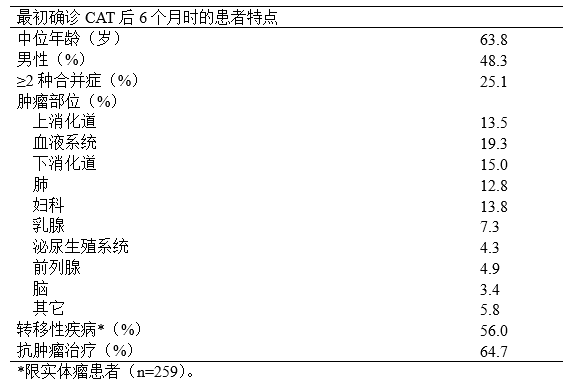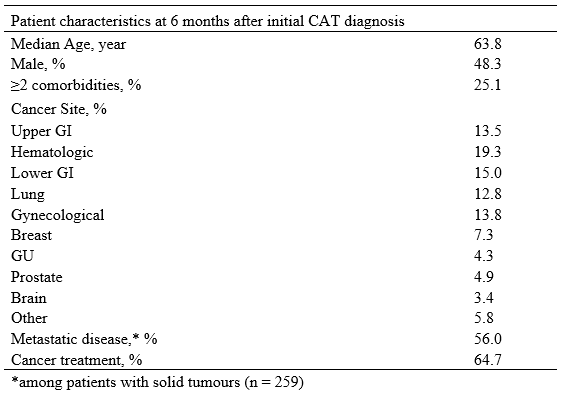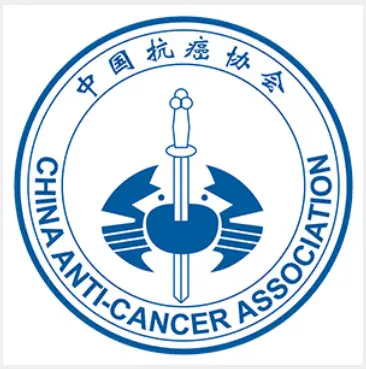点评:吴世凯

北京肿瘤医院 日间病房 住院医师
内科学博士 毕业于北京大学医学部
确诊癌症相关血栓6个月后患者的临床特点及长期预后
第一作者:Robert Adam Schmidt,Department of Internal Medicine, University of British Columbia, Vancouver, BC, Canada
癌症相关血栓(cancer associated thrombosis, CAT)是恶性肿瘤的常见并发症。然而,我们对CAT最初3-6个月治疗周期以后的临床病程所知甚少,这些信息对临床医生和患者进行有关抗凝持续时间的决策十分重要。
方法
回顾2013-2015年期间在Vancouver General Hospital血栓诊所因CAT(除外导管相关血栓)就诊的523例连续患者;327例在诊断CAT6个月后存活。总结该“幸存者”队列患者的临床及肿瘤特点、确诊CAT 6-24个月内客观记录的复发性静脉血栓栓塞(recurrent venous thromboembolism,rVTE)、临床相关出血(clinically relevant bleeding,CRB)及全因死亡情况。
结果
在该6个月幸存者队列中,患者中位随访时间为605天(范围1-730天),85.9%的患者至少随访24个月或发生死亡。患者在确诊6个月时的临床特点概括如下表。68.8%的患者继续应用抗凝,中位持续时间93天;54.3%的病人日应用抗凝。在最初确诊CAT后的6-24月期间,30例患者出现了34例次rVTE(9.2%;95%CI 6.3-12.8),14例患者发生了16例次CRB(4.3%; 95% CI 2.4–7.1),对应于随访期间每100病人日发生2.9例rVTE及1.4例CRB。21例(61.8%)rVTE事件和11例(68.8%)CRB事件发生于抗凝治疗期间。确诊18个月后,141例(43.1%;95%CI 37.7 – 48.7 )患者死亡。死亡原因包括癌症(80.9%)、rVTE(1.4%)、出血(2.8%)、其它原因(7.8%)及原因未知(7.1%)。抗凝期间发生3例致命性出血及2例致命性rVTE。
结论
血栓确诊6个月后存活的CAT患者仍然具有rVTE、CRB及死亡的高风险。

专家点评

吴世凯教授,主任医师,博士,博导,知名肿瘤专家,全军肿瘤中心副主任,放疗中心主任。国家新药审评专家、美国临床肿瘤学会会员、中国老年肿瘤学会常委副秘书长、中国老年肿瘤学会分子靶向治疗专委会主任委员、中国医疗发展和促进学会癌症姑息和康复专委会副主任委员、中国抗癌协会乳腺癌专委会委员、中国抗癌协会化疗专委会委员、中国抗癌协会癌症姑息康复专委会委员、中国成人癌痛NCCN指南专家组成员执笔人、北京肿瘤防治研究会执委会主任委员、北京乳腺病防治学会放疗专委会主任委员、北京抗癌协会癌症姑息康复委员会副主任委员、北京医学会肿瘤专委会常委、北京医学会放疗专委会常委、全军放疗专业委员会常委。
肿瘤患者在诊疗过程中常常伴发癌症相关血栓(CAT),严重影响患者生活质量,延误正常抗肿瘤治疗实施,从而降低患者生存期,但关于CAT发生后的大样本随诊研究报道较少。
加拿大温哥华总医院的这项研究提供了重要的随诊结果。共523例确诊为CAT患者,随诊6个月后,327例患者存活,对这些存活患者随诊结果发现,68.8%患者还在继续应用抗凝药,54.3%病人日应用抗凝药,9.2%患者再次发生rVTE,4.3%患者发生出血,4.2%患者最终死于CAT。本研究结果提示我们应该重视肿瘤诊疗中的CAT问题,积极开展CAT的相关临床研究,提高肿瘤患者CAT防治水平。
附摘要原文
10057 Poster Session (Board #45), Mon, 1:15 PM-4:45 PM
Patient characteristics and long-term outcomes beyond the first 6 months after a diagnosis of cancer-associated thrombosis.
First Author: Robert Adam Schmidt, Department of Internal Medicine, University of British Columbia, Vancouver, BC, Canada
Background: Cancer associated thrombosis (CAT) is a common complication of malignancies. However, little is known about the clinical course of CAT beyond the initial treatment period of 3 to 6 months. This information is important for clinicians and patients to inform their decision regarding duration of anti-coagulation.
Methods: Health records from 523 consecutive patients managed at the Vancouver General Hospital Thrombosis clinic for CAT (excluding catheter-related thrombosis) between 2013 and 2015 were reviewed; 327 were alive at 6 months post initial CAT diagnosis. Patient and cancer characteristics, objectively documented recurrent venous thromboembolism (rVTE), clinically relevant bleeding (CRB), and overall mortality of this “survivor” cohort over month 6 to 24 are described.
Results: In the 6 month survivor cohort, patients were followed for a median of 605 days (range 1 to 730) and 85.9% had at least 24 months of follow-up or died. Patient characteristics at 6 months are summarized (Table). Anticoagulation was continued in 68.8%, with a median duration of 93 days; 54.3% of patient-days were on anticoagulation. In the 6 to 24 months after the initial CAT diagnosis, there were 34 rVTE in 30 patients (9.2%; 95% CI 6.3 - 12.8) and 16 CRB in 14 (4.3%; 95% CI 2.4–7.1) patients, corresponding to 2.9 rVTE per 100 patient-days and 1.4 CRB per 100 patient-days of follow-up. Twenty-one (61.8%) rVTE events and 11 CRB episodes (68.8%) occurred on therapeutic anticoagulation. Over the 18 months, 141 (43.1%; 95%CI 37.7 – 48.7) patients died. Causes of death were cancer (80.9%), rVTE (1.4%), bleeding (2.8%), other (7.8%), and unknown (7.1%). Three fatal bleeds and 2 fatal rVTE occurred while on anticoagulation.
Conclusions: Patients with CAT who are alive at 6 months after VTE diagnosis remain at high risk of rVTE, CRB and death.















 苏公网安备32059002004080号
苏公网安备32059002004080号


